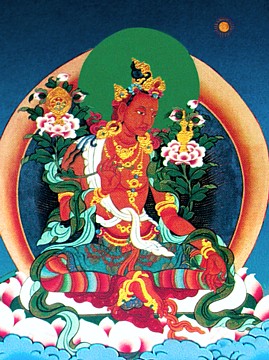Five Treatises of Maitreya: Difference between revisions
Jump to navigation
Jump to search
(Only first Wyl. is a link as per normal Media Wiki standard) |
No edit summary |
||
| Line 1: | Line 1: | ||
[[Image:Maitreya.jpg|frame|'''Maitreya''']] | [[Image:Maitreya.jpg|frame|'''Maitreya''']] | ||
'''Five Treatises of Maitreya''' (Tib. བྱམས་ཆོས་སྡེ་ལྔ་, [[Wyl.]] ''byams chos sde lnga'') — the [[bodhisattva]] [[Maitreya]], who will be the next buddha after [[Shakyamuni]], transmitted the root teachings to [[Asanga]], who transcribed them as the ‘Five Treatises of Maitreya’. | '''Five Treatises of Maitreya''' (Tib. བྱམས་ཆོས་སྡེ་ལྔ་, [[Wyl.]] ''byams chos sde lnga'') — the [[bodhisattva]] [[Maitreya]], who will be the next buddha after [[Shakyamuni]], transmitted the root teachings to [[Asanga]], who transcribed them as the ''‘Five Treatises of Maitreya’''. Mipham Rinpoche says: | ||
:After the noble bodhisattva Asanga performed the practice of Lord Maitreya for twelve human years, he met Maitreya face-to-face and was led to the heavenly realm of Tushita. Maitreya presented Asanga with five commentaries that comment upon the wisdom intent of all the words of the Victorious One. These five treatises are the ''Two Ornaments'', the ''Two Treatises That Distinguish'', and the ''Sublime Continuum''. <ref> At the very beginning of his commentary on ''Distinguishing the Middle from the Extremes''.</ref> | |||
Among the five, four are classed as [[shastra]]s (commentaries) proper, and one falls into the class of oral instructions. The four that are shastras are extensive are: | Among the five, four are classed as [[shastra]]s (commentaries) proper, and one falls into the class of oral instructions. The four that are shastras are extensive are: | ||
Revision as of 06:24, 10 September 2017

Five Treatises of Maitreya (Tib. བྱམས་ཆོས་སྡེ་ལྔ་, Wyl. byams chos sde lnga) — the bodhisattva Maitreya, who will be the next buddha after Shakyamuni, transmitted the root teachings to Asanga, who transcribed them as the ‘Five Treatises of Maitreya’. Mipham Rinpoche says:
- After the noble bodhisattva Asanga performed the practice of Lord Maitreya for twelve human years, he met Maitreya face-to-face and was led to the heavenly realm of Tushita. Maitreya presented Asanga with five commentaries that comment upon the wisdom intent of all the words of the Victorious One. These five treatises are the Two Ornaments, the Two Treatises That Distinguish, and the Sublime Continuum. [1]
Among the five, four are classed as shastras (commentaries) proper, and one falls into the class of oral instructions. The four that are shastras are extensive are:
- 1. The Ornament of Clear Realization (Skt. Abhisamayalankara, Abhisamayālaṃkāra; Tib. མངོན་པར་རྟོགས་པའི་རྒྱན་, ngönpar tokpé gyen, Wyl. mngon par rtogs pa'i rgyan).
- 2. The Ornament of the Mahayana Sutras (Skt. Mahayanasutralankara, Māhayānasūtrālaṃkāra; Tib. ཐེག་པ་ཆེན་པོའི་མདོ་སྡེ་རྒྱན་, tekpa chenpö do de gyen, Wyl. theg pa chen po'i mdo sde rgyan).
- 3. Distinguishing the Middle from the Extremes (Skt. Madhyantavibhaga, Madhyāntavibhāga; Tib. དབུས་དང་མཐའ་རྣམ་པར་འབྱེད་པ་, ü dang ta nampar jepa, Wyl. dbus dang mtha' rnam par 'byed pa).
- 4. Distinguishing Dharma and Dharmata (Skt. Dharma-dharmata-vibhaga, Dharma-dharmatā-vibhāga; Tib. ཆོས་དང་ཆོས་ཉིད་རྣམ་པར་འབྱེད་པ་, chö dang chönyi nampar jepa, Wyl. chos dang chos nyid rnam par 'byed pa) is very brief and direct in its presentation and is included within the class of oral instructions.
- 5. The Sublime Continuum (Skt. Uttaratantra Shastra, Uttaratantra Śāstra; Tib. རྒྱུད་བླ་མ་, gyü lama, Wyl. rgyud bla ma).
Overview
Khenpo Shenga[2] says:
- "The treatises are:
- The Ornament of Clear Realization, which explains the intent of the sutras teaching profound emptiness;
- The Ornament of Sutras and the two ‘Distinguishing’s, which explain the intent of the sutras teaching the aspect of extensive conduct; and
- The Sublime Continuum, which explains the intent of the sutras teaching the inconceivable nature of reality (dharmata).
- Moreover, these texts were given for the sake of guiding three types of individual:
- The three intermediate treatises of Maitreya were composed for those to be trained through the teachings of the mahayana Mind Only system of philosophy;
- The Ornament of Clear Realization was composed for those to be trained through the teachings of the mahayana Svatantrika system; and
- The Sublime Continuum was composed for those to be trained through the teachings on the mahayana Prasangika system."
Notes
- ↑ At the very beginning of his commentary on Distinguishing the Middle from the Extremes.
- ↑
 Prologue to Abhisamayalankara Commentary by Khenchen Shenga
Prologue to Abhisamayalankara Commentary by Khenchen Shenga